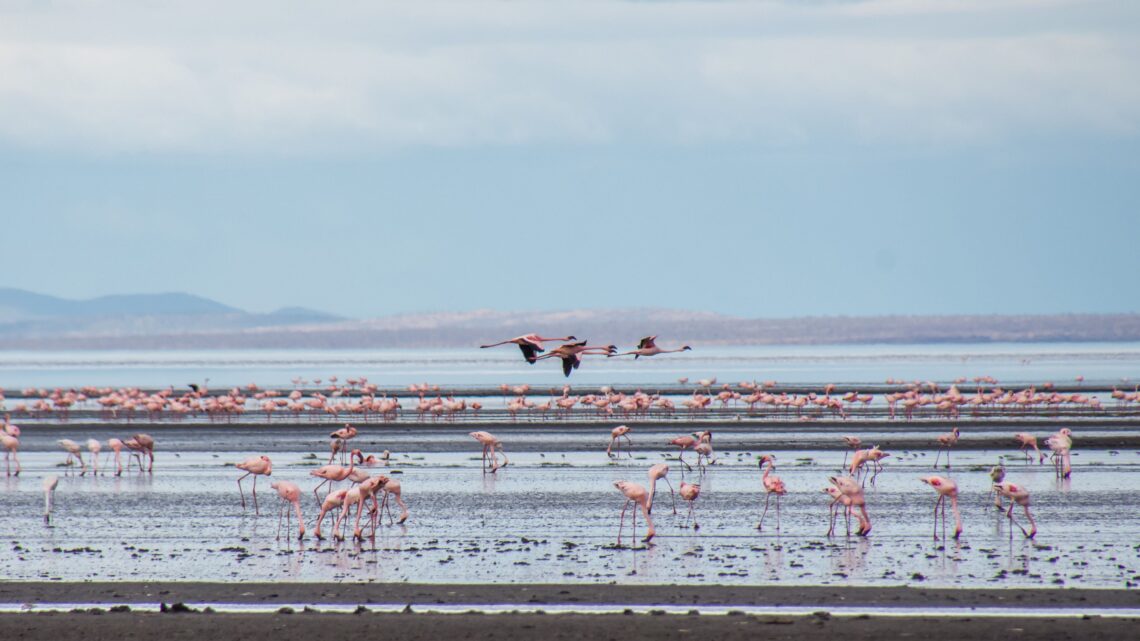In Tanzania, there is an extraordinary lake that’s so deadly it can turn animals into stone. Lake Natron is infamous for its striking red color and extremely hostile conditions. Its toxic waters can instantly mummify wildlife, but surprisingly, flamingos can survive the harsh environment and even flock to the area to mate.
Scroll down for more on this story.
Deadly Red Lake

Located in northern Tanzania, near the border of Kenya, the body of water has a deadly combination of high salt concentration and alkalinity. Its average alkalinity is 10.5, with a pH that surpasses 12, and a temperature that ranges from 40˚ to 60˚C.
Wonder Of Nature
Its hypersaline water makes it a wonder of nature. But, it is deadly to animals, especially birds who can be instantly turned into stone and petrified forever.
Rapid Decomposition

Animals that fall into the water can decompose rapidly. Those who fall on the edge of the water are preserved and encrusted in salt.
It Turns Bright Red
Its highly alkaline waters are the perfect environment for algae blooms to thrive. The bright red color is bacteria that flourish in the water during certain seasons. The lake’s red color is not fixed and can subside depending on the water’s conditions.
Bacteria Thrive In The Waters
When algae blooms thrive, the bright red lake with mosaic-like structure can be seen from the sky. Cyanobacteria are some of the only organisms that survive the highly toxic waters and extremely high temperatures.
Nearby Volcano

The nearby volcano, Ol Doinyo Lengai, also called the Mountain of God, is what makes the waters of Lake Natron lethal to animals and other wildlife. The active volcano spews a rare kind of lava called Natrocarbonatite into the stream channels of the lake.
Catch Basin
Much like the Dead Sea, Lake Natron doesn’t run off into other bodies of water. Its catch basin structure makes the chemicals in the waters even more concentrated.
Ammonia pH Level

The salty lake has a high pH level that’s close to ammonia. If an unsuspecting animal dives into the waters, they become calcified. Birds that drink the water from the lake also wind up dead.
Stone Birds
In 2013, photographer Nick Brandt discovered calcified birds in the area when he walked the lake during the dry season. He was one of the first to document the strange phenomenon.
Strange Creatures
“I unexpectedly found the creatures — all manner of birds and bats — washed up along the shoreline of Lake Natron,” he wrote in his book, Across the Ravaged Land.
Toxic Waters
“No one knows for certain exactly how they die, but … the water has an extremely high soda and salt content, so high that it would strip the ink off my Kodak film boxes within a few seconds,” he said.
Turning Them To Art
“I took these creatures as I found them on the shoreline, and then placed them in ‘living’ positions, bringing them back to ‘life,’ as it were,” he continued.
Flamingo-Friendly
While many birds have died on Lake Natron, it has become a safe haven for flamingos. They flock to the red lake to mate and also eat the bacteria living in the waters.
Largest Breeding Ground In Africa
During the mating season, over 2 million lesser flamingos use the lake as their primary breeding ground.
Flamingos Eat Cyanobacteria
Not only do they use the lake as mating grounds, but they have also made the algae-rich water a food source.
Unharmed By The Chemicals

Because flamingos have tough skin and scaly legs, they are protected from being burned. They also have strong stomachs that can withstand the salty water, allowing them to feed on the algae.
Preserved Footprints

The lake also had a major role in helping preserve footprints from as far back as 19,000 years ago.
Important History
In 2016, geologists were able to find more than 400 footprints of early humans in the mudflat area of Lake Natron. It is believed that the conditions of the lake helped preserve the prints in the mud. No other site in Africa has this many homo sapien footprints.
A True Wonder
The lake may have been dubbed as one of the most dangerous places to be in but it is certainly a true wonder of our world!















































